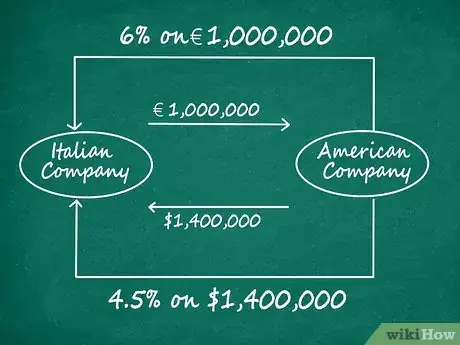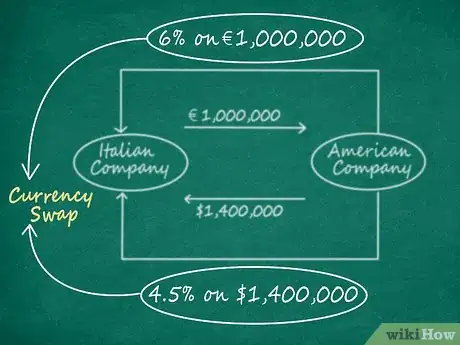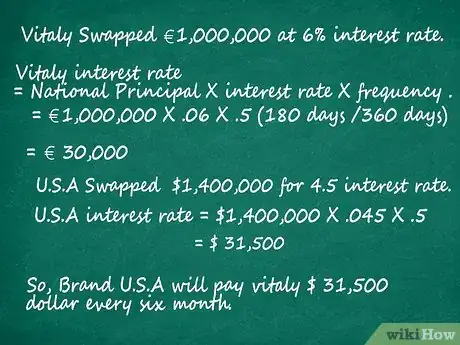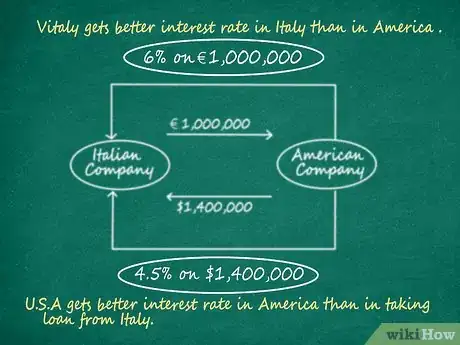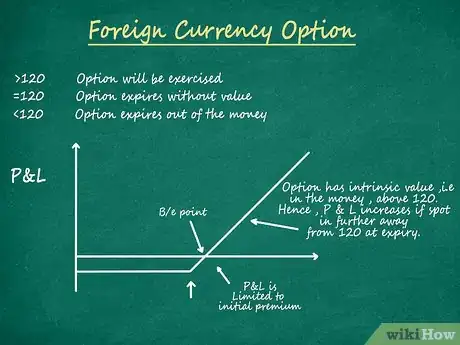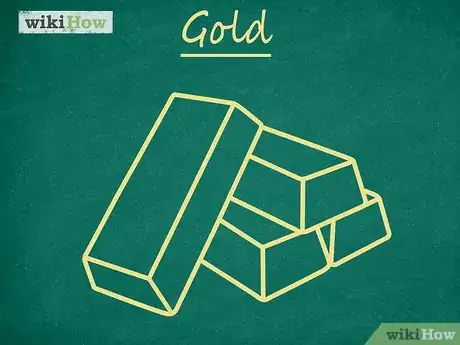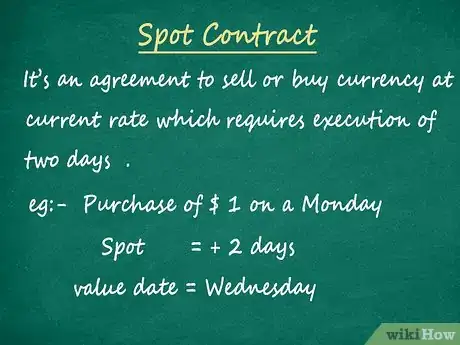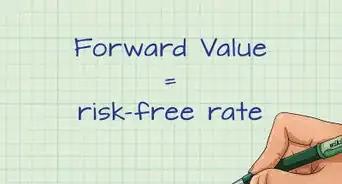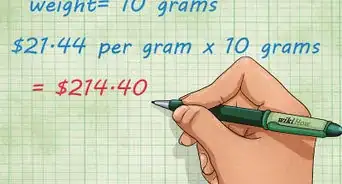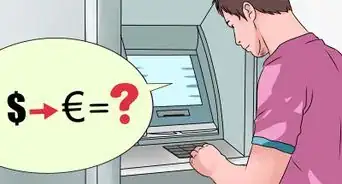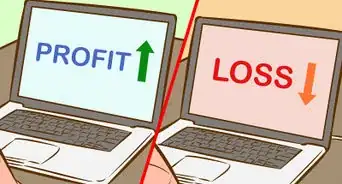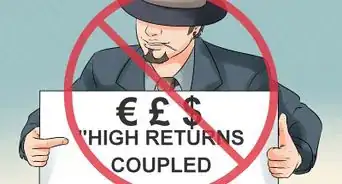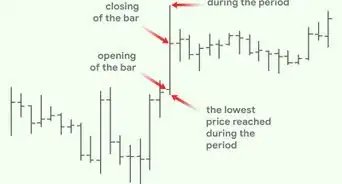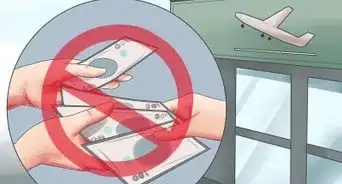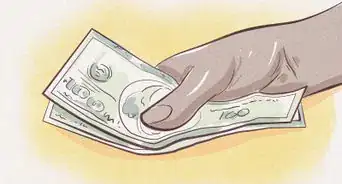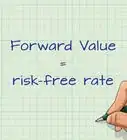This article was co-authored by Gina D'Amore. Gina D'Amore is a Financial Accountant and the Founder of Love's Accounting. With 12 years of experience, Gina specializes in working with smaller companies in every area of accounting, including economics and human resources. She holds a Bachelor's Degree in Economics from Manhattanville College and a Bookkeeping Certificate from MiraCosta College.
There are 9 references cited in this article, which can be found at the bottom of the page.
This article has been viewed 181,078 times.
The hedge is an insurance policy. Whether you're transacting business abroad or simply holding onto foreign currencies as an investment, a fluctuation in currency can cause serious losses very quickly. A hedge is a way to guard against this: Invest in a position that offsets (bets against) an investment you already own, and any losses in one position will be buoyed up by gains in the other.
Steps
Hedging with Currency Swaps
-
1Swap currencies and interest rates with a party in a currency swap. In a such a swap, two parties agree to swap equivalent amounts of cash (called principal) as well as interest rate payments over a fixed period of time.[1] The cash usually originates as debt (a party issues a bond) or as credit (a party gets a loan). The principals exchanged are usually equivalent amounts: Party A swaps $1,000,000 for €750,000 from Party B, based on the exchange rate. The swapped interest rate payments, however, are usually not the same.
- Here's a very basic example. Vitaly Partners, an Italian company, wants to hedge against the euro by buying dollars. Vitaly agrees on a currency swap with Brand USA, an American company. Over five years, Vitaly sends Brand USA €1,000,000 in exchange for the dollar equivalent, about $1,400,000. Vitaly agrees to swap interest payments with Brand USA as well: Vitaly will pay Brand USA 6% interest on its swapped principal, €1,000,000, while Brand USA will pay Vitaly 4.5% interest on its swapped principal, $1,400,000.
-
2Exchange interest payments in a currency swap, not principals. The principal that the two parties agree to swap isn't actually exchanged. It is kept by both parties. The principal is what financiers call a notional principal, or an amount that is theoretically exchanged but actually kept. [2] Why is the principal needed, then? It's needed to calculate the interest payments, which are the backbone of any currency swap.Advertisement
-
3Calculate your interest rate payment. Interest rate payments are usually swapped at six-month or one-year intervals, and this is where the parties transfer currencies that help them hedge against fluctuations in their own currency.[3] Let's look at an example:
- Vitaly agreed to swap €1,000,000 at 6% to Brand USA in exchange for $1,400,000 at 4.5%. Let's assume that interest rate payments are swapped every six months.
- Vitaly's interest rate payment will be calculated as follows: Notional principal x interest rate x frequency. Every six months, Vitaly will pay Brand USA €30,000, in euros. (€1,000,000 x .06 x .5 [180 days/360 days] = €30,000.)
- Brand USA's interest rate payment will be calculated as follows: $1,400,000 x .045 x .5 = $31,500. Brand USA will pay Vitaly $31,500, in dollars, every six months.
-
4Work with a partnering financial institution to mediate the swap. For simplicity, this example so far has avoided a third party that's involved in the swap — banks. When Vitaly sends its interest payments over to Brand USA, it does so by sending the bank the interest payment first; the bank takes a small cut and sends the rest of the interest payment on over to Brand USA. Ditto for Brand USA: it must also mediate the transaction through the bank, which takes a small cut from their swap for granting the privilege.
-
5Use currency swaps if you get better loan rates at home than you do abroad. Why choose currency swaps instead of just buying foreign currency? Currency swaps involve two parties. Remember Vitaly and Brand USA. Vitaly gets a better interest rate on its loan of €1,000,000 in Italy than it would if it asked for the loan in America. Likewise, Brand USA gets a better interest rate on its $1,400,000 loan in America than it would if it got the loan in Italy. By agreeing to exchange interest rate payments, currency swaps bring together two parties that each have better loan agreements in their own countries and their own currencies. [4]
Hedging with Forward Contracts
-
1Purchase forward contracts. A forward contract is like a futures contract or derivative. It is an agreement to buy or sell a currency at a fixed price on a certain date.[5] Here's an example:
- Dave is worried that the price of the dollar is going to plummet relative to the British pound. He has $1,000,000 in cash, which would fetch him about £600,000 at the then-current exchange rate. Dave wants to use a forward contract to lock in the exchange rate of the dollar relative to the pound. Here's what Dave does:
- Dave offers to sell Vivian $1,000,000 of US currency in exchange for £600,000 of British currency in six months. Vivian accepts the deal. This is a "forward contract."
-
2Evaluate the forward contract at the agreed-upon time. Let's continue with our example of Dave offering a forward contract to Vivian. In six months (the agreed-upon time), there are three possible outcomes regarding the price of the dollar relative to the pound.[6] Each of these possibilities affects the forward contract:
- The price of the dollar goes up relative to the pound. Hypothetically, let's say one dollar now fetches .75 pound instead of .6 pound. Dave pays Vivian the difference between the current price of exchange and the price agreed upon in the contract: ($1,000,000 x .75) - ($1,000,000 x .6) = $150,000.
- The price of the dollar goes down relative to the pound. Hypothetically, let's say one dollar now fetches .45 pound instead of .6 pound. Vivian agreed to pay Dave .6 pound for each of his dollars six months ago, so Vivian has to pay Dave the difference between the price agreed upon in the contract and the current price: ($1,000,000 x .6) - ($1,000,000 x .45) = $150,000.
- The exchange rate between the dollar and the pound stays the same. No exchange happens between partners in the contract.
-
3Use forward contracts as a way to hedge against currency drops and spikes.[7] Like any derivative, a forward contract is a great way to ensure you don't lose a lot of money if a currency you have a sizable position in drops in value. Here's how Dave came out by using a forward contract:
- If the dollar gained in value, Dave is a winner, although he still has to pay out. If one dollar fetches .75 pound instead of .6, Dave has to pay Vivian $150,000, but his million dollars suddenly buys a lot more pounds.
- If the dollar fell in value, Dave isn't a loser. Remember, Vivian owes him the exchange rate they agreed upon at the beginning of the contract. So it's as if the value of the dollar never fell. Dave takes the payout, none the poorer than he was before.
Other Hedging Options
-
1Buy foreign currency options. Foreign currency options give the purchaser the option to sell or buy a foreign currency contract at a specific price on a specific date. This hedging technique is similar to forward contracts, except that the owner of the option is not required to exercise the option.[8]
- When the specific date (known as the expiration date) of the contract arrives, the buyer of the contract can exercise the option at the agreed price (known as the strike price), if currency fluctuations have made it profitable for him/her. If fluctuations have made the option worthless, it expires without the company or individual exercising it.
-
2Buy gold. You can use gold and other precious metals to hedge currency positions. Investors have used gold as a hedge since ancient times, and many investors still keep gold in their portfolios to guard against economic pitfalls or disasters.[9]
-
3Exchange some of your native currency for a foreign currency. One of the simplest ways to hedge your currency holdings is to buy some foreign currencies. If you live in a country that uses the Euro, for example, you can buy U.S. dollars, Swiss francs or Japanese yen (among others). If the value of the Euro drops relative to the other currencies, you’ve sheltered yourself to the extent that you own the other currencies.
-
4Buy spot contracts. A spot contract is an agreement to sell or buy foreign currency at the current rate and requires execution within two days. Spot contracts are essentially the opposite of futures contracts, where the deal is agreed upon well before the assets or goods are delivered, if at all.[10]
Expert Q&A
-
QuestionIs hedging always profitable?
 Gina D'AmoreGina D'Amore is a Financial Accountant and the Founder of Love's Accounting. With 12 years of experience, Gina specializes in working with smaller companies in every area of accounting, including economics and human resources. She holds a Bachelor's Degree in Economics from Manhattanville College and a Bookkeeping Certificate from MiraCosta College.
Gina D'AmoreGina D'Amore is a Financial Accountant and the Founder of Love's Accounting. With 12 years of experience, Gina specializes in working with smaller companies in every area of accounting, including economics and human resources. She holds a Bachelor's Degree in Economics from Manhattanville College and a Bookkeeping Certificate from MiraCosta College.
Financial Accountant Not really. It's always a huge risk. The idea of a hedge fund is that one is going to win and you're taking a hard bet. A hedge fund is never like, "Oh, this is something that is gonna grow at 3%". You're always betting that something new is gonna grow at 30%. So, the risk is really high.
Not really. It's always a huge risk. The idea of a hedge fund is that one is going to win and you're taking a hard bet. A hedge fund is never like, "Oh, this is something that is gonna grow at 3%". You're always betting that something new is gonna grow at 30%. So, the risk is really high. -
QuestionIs Foreign Exchange Rate Risk relevant?
 Community AnswerYes, for example if you go to Corfu in Greece you will find that 200 pounds is the same as 194.45 pounds, so there are sometimes risks in the exchange rate.
Community AnswerYes, for example if you go to Corfu in Greece you will find that 200 pounds is the same as 194.45 pounds, so there are sometimes risks in the exchange rate.
Expert Interview
Thanks for reading our article! If you'd like to learn more about hedging, check out our in-depth interview with Gina D'Amore.
References
- ↑ https://www.investopedia.com/articles/forex/11/hedging-with-currency-swaps.asp
- ↑ http://www.investopedia.com/terms/n/notionalprincipalamount.asp
- ↑ https://www.investopedia.com/articles/forex/11/hedging-with-currency-swaps.asp
- ↑ http://www.investopedia.com/ask/answers/06/benefitsofswaps.asp
- ↑ https://investinganswers.com/dictionary/f/forward-contract
- ↑ https://economictimes.indiatimes.com/wealth/invest/what-are-forward-contracts/articleshow/63948764.cms?from=mdr
- ↑ https://businessjargons.com/risk-hedging-with-forward-contracts.html
- ↑ https://www.accountingtools.com/articles/2017/5/15/foreign-currency-option
- ↑ https://seekingalpha.com/article/4233235-hedge-for-chaos-invest-in-gold
About This Article
To hedge currency, you have several options, including swapping currencies and interest rates with a party in a currency swap or purchasing a forward contract, which is an agreement to buy or sell a currency at a fixed price on a certain date. You can also hedge currency by purchasing gold or other precious metals. If you're looking for a fast, easy solution, try exchanging some of your native currency for a foreign currency so you're sheltered if the value of your native currency drops. To learn how to hedge currency with foreign currency options, scroll down!
